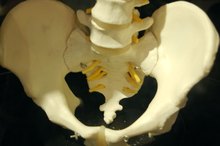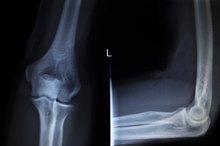Range of Motion in Men Vs. Women
The blueprints for the male and female anatomy show few variances. Male and female hormones and their effect on bone structure and reproduction are the main factors that create differentiation. While the typical male form is generally larger than the female form, muscle strength and the pliability of tendons and ligaments is often a case of relativity. All of these factors take precedence when determining the differences in male and female range of motion.
If you are experiencing serious medical symptoms, seek emergency treatment immediately.
Lumbar Flexibility
In the book “Joint Range of Motion and Muscle Length Testing,” researcher Nancy Reese says differences in male and female range of motion in the lumbar — the area between diaphragm and pelvis — regions are greatly determined by age 2. As children, females generally have more lumbar flexibility than males until the age of nine when males catch up. Range of motion equality generally ends between ages 18 and 35 as males develop more lumbar extension than females and females more lateral flexion, or sideways movement of the spine.
Hormonal Roles
Male Vs. Female Skeleton
Learn More
The male and female sex hormones — testosterone and estrogen — play pivotal roles in muscle size and flexibility. Testosterone increases everything from the size and mass of muscles to the male skeleton. According to the U.S. Office of Science, the male-female muscle comparison becomes particularly polarized when it comes to the upper body where muscle fibers and lean tissues are much larger in the male physique 1. In contrast, estrogen widens the hips of females adding greater muscle mobility in abdominal regions.
- The male and female sex hormones — testosterone and estrogen — play pivotal roles in muscle size and flexibility.
- According to the U.S. Office of Science, the male-female muscle comparison becomes particularly polarized when it comes to the upper body where muscle fibers and lean tissues are much larger in the male physique 1.
Hip Action
When it comes to hip action females dominate the range of motion scene at all ages, says Reese. Increased hip flexibility is a byproduct of female hormones that for millennia have been working their magic to prepare women for pregnancy. In the book “Women’s Health and Fitness Guide,” Dr. Michele Kettles says the majority of added hip motion in females originates at the pelvis 3. Range of motion is boosted through greater tailbone mobility, downward pelvic tilt and the wider and more circular pelvis of females.
- When it comes to hip action females dominate the range of motion scene at all ages, says Reese.
- In the book “Women’s Health and Fitness Guide,” Dr. Michele Kettles says the majority of added hip motion in females originates at the pelvis 3.
Joint Instability
The Male & Female Pelvic Differences
Learn More
During puberty, females undergo bone and muscle changes that often create laxity, or joint instability, that limit neuromuscular control in lower extremities. To compensate for this lack of control, female knee joints tend to rotate inward as weight is applied. This places strain on tendons and ligaments that increases the risk of tear and injury. According to Kettles, male knee joints do not rotate and rely solely on flexion and extension instead of muscle instead of anterior knee ligaments.
- During puberty, females undergo bone and muscle changes that often create laxity, or joint instability, that limit neuromuscular control in lower extremities.
Upper Extremity
Research published in the journal “Medicine and Science in Sports and Exercise” in 2000, reported differences in shoulder joint range of motion in men and women. The study found women to have more anterior shoulder joint laxity and hypermobility and less stiffness when compared to men. Differences in elbow and hand — fingers and wrists — range of motion have traditionally found females to have greater mobility and increased flexibility in all areas except wrist flexion, according to Reese.
Related Articles
References
- US Office of Science: Male Vs. Female Muscles
- “Joint Range of Motion and Muscle Length Testing”; Nancy Reese, et al; 2002
- “Women’s Health and Fitness Guide”; Michele Kettles, M.D.; 2006
Resources
- “Medicine and Science in Sports and Exercise”; P.A. Borsa, et al; 2000
Writer Bio
Based near America's "Gateway to the West," Li St. Michael has been writing professionally since 2005. Her culturally minded articles have appeared on various websites. St. Michael holds a Bachelor of Science in writing from Drury University and is set to receive a Masters degree in international relations in 2011.









